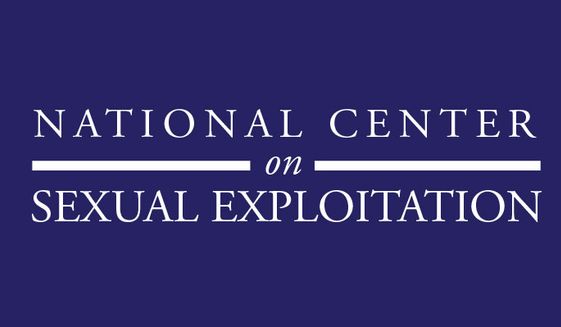‘Tsunami’ of pornography (mis)shaping next generation

A “tsunami” of obscene, violent and degrading pornography is harming children, women, men and the American culture, a panel of experts told a Capitol Hill briefing Tuesday.
The standing-room-only event was organized by the National Center on Sexual Exploitation and led by NCSE officials Patrick Trueman and Dawn Hawkins.
Panelists urged members of Congress to see that pornography is linked to sexual victimization, prostitution, human trafficking, child abuse and addiction — and hold hearings on these topics.
All of this makes pornography “a public health crisis,” said therapist Cordelia Anderson, an advocate for child abuse victims. It’s a “sexual tsunami,” said psychotherapist Mary Anne Layden, a specialist in treatment of sexual abuse victims and perpetrators.
Public education is needed about modern-day pornography and how it is impacting people, said Ms. Anderson. She described a young adult man who uses pornography and now has premature erectile dysfunction, and a child rape victim, now a mother, who is worried about her stubborn addiction to violent pornography.
Ed Smart, left, and daughter Elizabeth Smart talk to reporters before her speech at Scotts Hill High School, where missing Tennessee woman Holly Bobo graduated, on Monday, Aug. 27, 2012 in Scotts Hill, Tenn. Elizabeth Smart, now 24, was abducted in 2002 at age 14 and was held for nine months before she was found just miles from her Utah home. She told Bobo's friends and family Monday night to keep searching for Bobo and don't give up hope she is alive. (AP Photo/Adrian Sainz)
Ed Smart, left, and daughter Elizabeth Smart talk to reporters before her ... more >
Another case is a divorcing couple, where the wife says pornography killed their marriage. “He can’t look at me anymore. He’s not aroused by me. He’s only aroused by pornography,” the woman said of her husband, Ms. Anderson said.
People may also be unaware of the extreme violence in today’s pornography, said clinical psychologist Melissa Farley, executive director of Prostitution Research and Education in San Francisco.
One pornographic torture website, she said, has shown images of a man stuffing a rag in a woman’s mouth, sewing her mouth shut and hanging her on a wall.
“Pornographers count on our tolerance for social injustice,” said Ms. Farley. Pornography is “a hydra-headed industry” that is completely linked to prostitution and trafficking.
Ed Smart, father of former captive Elizabeth Smart and an official with the child-rescuing Operation Underground Railroad, gave a wrenching description of his then-14-year-old daughter’s abuse at the hands of long-time pornography user Brian David Mitchell.
Mitchell, now imprisoned, had been exposed to pornography as a child by his father, who thought it was harmless.
The irresistible images led Mitchell into a life of ever-increasing sexual risk-taking behaviors, leading to his kidnapping of the teen from her home at knife point in 2002.
During his daughter’s nine months of captivity, the rapist would do especially vile things to her after viewing pornography, Mr. Smart said, adding that it is still used to instruct people, including children; desensitize them, and drive experimentation with sexually deviant activities.
Challenging the public-health problem of sexual exploitation will be akin to getting people to wear seat belts in vehicles, or stopping smoking, experts said.
It means a full-blown campaign to change the culture, backed by new laws and law enforcement, and exposing the pornography industry and the criminality and victimization that so often goes along with it, they said.
Solutions included stepping up enforcement of federal and state adult obscenity laws, which prohibit distribution of hardcore pornography on the internet, on cable/satellite TV, in hotels and motels and in retail shops and by carriers.
“Social activism” is also key, said sociology professor and author Gail Dines, founder and president of Culture Reframed.
No-smoking campaigns work to keep tobacco out of lungs; now it’s time to “keep pornography out of their eyes,” said Dr. Donald Hilton, a neurosurgeon and professor at the University of Texas Health Sciences Center. He and Dr. Sharon Cooper, a forensic pediatrician who is an expert on child abuse, spoke of the alarming impact pornography has on young minds.
America can look at what is being done in the United Kingdom, said Ernie Allen, former president and chief executive of the National Center for Missing & Exploited Children. There, he said, at the behest of Prime Minister David Cameron, Internet Service Providers are filtering pornographic content to consumers, while permitting them “opt out” of the filter.
Corporate responsibility could be a very fruitful angle, said Donna Rice Hughes, president and chief executive of Enough is Enough, who attended the Tuesday briefing.
Companies who want to create truly “family friendly” environments should block obscene images on their WiFi services, so people won’t end up standing next to someone in a store or sitting next to someone in the coffee shop while they are looking at torture sex or child pornography, said Ms. Hughes.
Past anti-pornography efforts failed in part because of they couldn’t surpass pornography industry’s First Amendment claims, or were trapped into debates about morality, noted Ms. Hughes.
“But now, we have peer-reviewed science to demonstrate harm and impact,” she said. “We can reframe the issue,” she said, noting that she had come to Congress in the 1990s to warn about the explosion of online torture, bestiality and child pornography on the new social medium — all of which has become even more entrenched.
